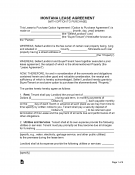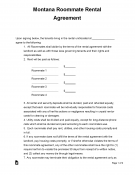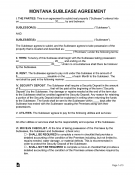Montana lease agreements bind landlords and tenants to terms governing a tenancy. Lease agreements will identify the monthly rent, specify which party is responsible for particular utilities, and include other terms particular to a property, such as a policy on pets. The landlord and the tenant should each keep a copy of the lease agreement, and refer to it in case of questions in order to prevent disputes.
Contents
- Montana Lease Agreements: By Type (6)
- Landlord-Tenant Laws
- Handbooks and Guides
By Type (6)
- Commercial Lease Agreement
- Month-to-Month Lease Agreement
- Rent-to-Own Lease Agreement
- Roommate Lease Agreement
- Standard Lease Agreement
- Sublease Agreement
Download: Adobe PDF, MS Word, Rich Text Format
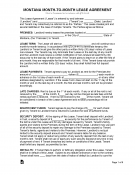 Month-to-Month Lease Agreement
Month-to-Month Lease Agreement
Download: Adobe PDF, MS Word, Rich Text Format
Download: Adobe PDF, MS Word, Rich Text Format
Download: Adobe PDF, MS Word, Rich Text Format
Download: Adobe PDF, MS Word, Rich Text Format
Download: Adobe PDF, MS Word, Rich Text Format
Landlord-Tenant Laws
Statutes – Title 70, Chapter 24 (Residential Landlord and Tenant Act of 1977), Chapter 25 (Residential Tenants’ Security Deposits)
Required Disclosures (5)
Mold Disclosure – Lease agreements, whether in the text itself or in an attached document, must disclose the history of the property with regards to mold, and whether there are any records on the matter. (§ 70-16-703)
Lead-Based Paint Disclosure – For leases of all properties with dwelling units built before 1978, federal law requires that the land disclose the dangers associated with lead-based paints.
Methamphetamine Drug Lab Disclosure – If a landlord knows that a property has previously been used as a lab for the production of methamphetamine or that has been contaminated from smoke from the use of methamphetamines and that since the lab’s closure the property has not been cleaned in conformance with stat decontamination standards, then the landlord must disclose this in the lease agreement. (§ 75-10-1305(3))
Move-in Checklist – If the landlord requires a security deposit, the landlord must provide to the tenant, along with the lease agreement, a written statement describing the conditions of the various parts of the property at the time of the beginning of the lease. (§ 70-25-206)
Landlord/Manager/Agent Identification – Landlords must include the names and means of contact of agents or managers who will be allowed to enter the property for purposes like making repairs, and who are able to receive notices or complaints from tenants. (§ 70-24-301)
Security Deposit Laws
Maximum Amount ($)
There is no statutory limit to the amount a landlord may require as a security deposit.
Returning to Tenant
Landlords may retain a portion of the security deposit only to cover unpaid rent, utility charges, late fees, and to pay for cleaning expenses and repairs beyond normal wear and tear. To better understand the costs associated with cleaning or repairs, a tenant may request an inspection of the premises to take place within one (1) week of terminating the tenancy (§ 70-25-201). The landlord must provide a written itemization of all deductions from the security deposit, along with any remaining funds, to the tenant within thirty (30) days of the termination of the tenancy; if an inspection reveals that there are no cleaning or repair costs and there in no owed rent, the deposit must be provided to the tenant within ten (10) days (§ 70-25-202). The itemization and funds should be sent by mail. The tenant’s failure to provide a new address to the landlord does not remove the landlord’s responsibility to provide the funds. (§ 70-25-205)
When is Rent Due? (grace period)
Montana law does not specify when rent is due or requires a grace period. Landlords and tenants may decide on the due date in the lease agreement.
Eviction Notice (non-payment)
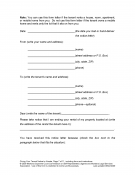 3-Day Notice to Pay or Quit – In instances in which a tenant fails to pay rent on the date it is due, a landlord has the right to terminate the lease, so long as the landlord or an agent delivers this notice to the tenant, explaining that the tenant must pay all owed rent within three (3) days or the landlord may end the lease. (§70-24-422)
3-Day Notice to Pay or Quit – In instances in which a tenant fails to pay rent on the date it is due, a landlord has the right to terminate the lease, so long as the landlord or an agent delivers this notice to the tenant, explaining that the tenant must pay all owed rent within three (3) days or the landlord may end the lease. (§70-24-422)
Download: Adobe PDF
Maximum Fees ($)
Late Rent Penalties
State law does not dictate how much a landlord may charge for providing late rent, but in order to be enforceable, a fee should be named in the lease agreement and must be reasonable.
NSF Checks
As with late rent fees, there is no set amount that landlords may charge for providing a bounced check, but the fee should be named in the lease agreement, and be reasonably related to the costs imposed by receiving a check with insufficient funds.
Tenant’s Unclaimed Property
Following the termination of a tenancy, other than one ended through a court order, if the landlord has clear and convincing evidence that the tenant has abandoned any personal property found in the leased dwelling unit, the landlord may remove the personal property within forty-eight (48) hours. The landlord may immediately dispose of property that is perishable, hazardous or valueless, but should inventory and store other property at a commercial storage space. The landlord may seek reimbursement from the tenant for storage costs, and is liable only for willful destruction of the property, not negligent acts. The landlord must make reasonable efforts to notify the tenant, including a written notice stating that the personal property may be disposed of within ten (10) days of mailing the notice. If the tenant does not respond, or responds in writing but does not actually come to claim the property within seven (7) days of writing, the landlord may sell the property, publicly or privately, or may destroy it. (§70-24-430)

